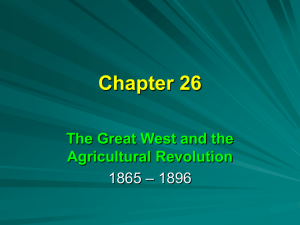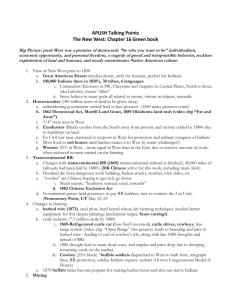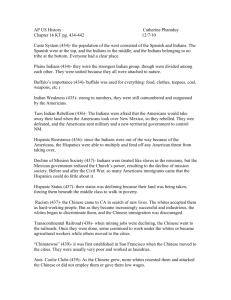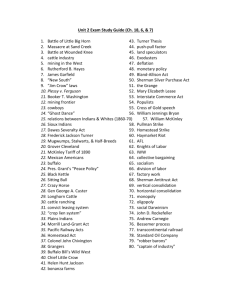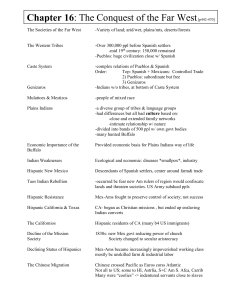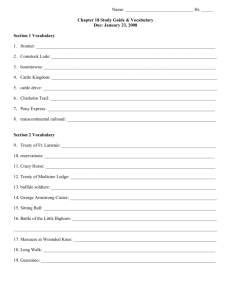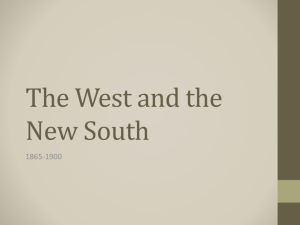APUSH16 - TheWest - EHS
advertisement
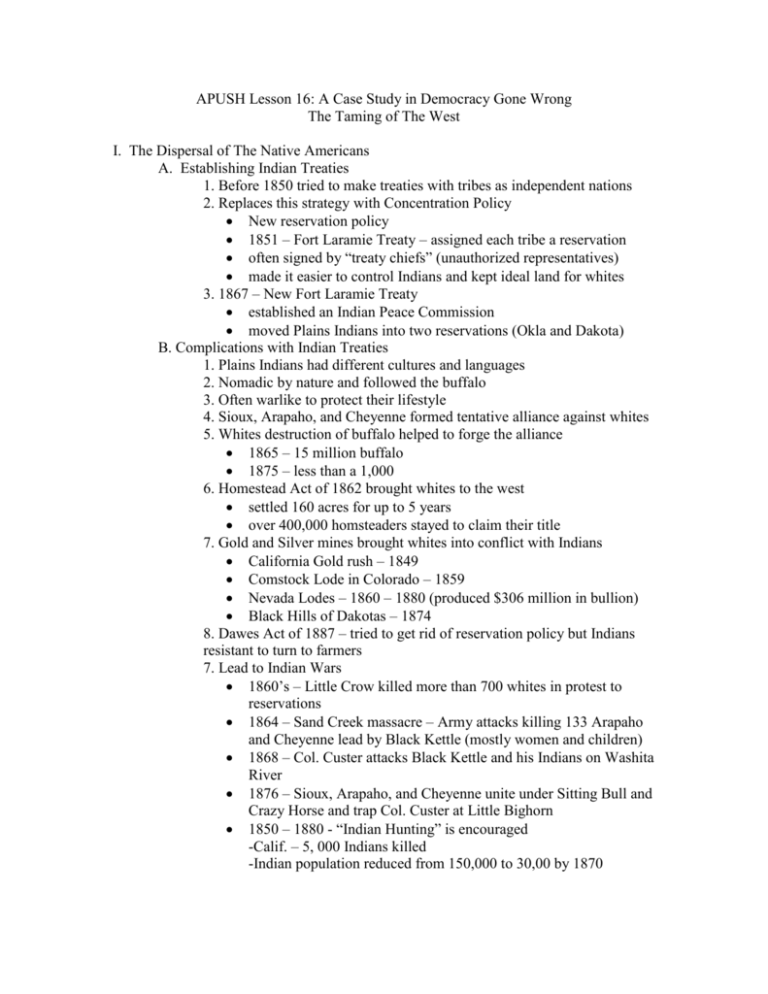
APUSH Lesson 16: A Case Study in Democracy Gone Wrong The Taming of The West I. The Dispersal of The Native Americans A. Establishing Indian Treaties 1. Before 1850 tried to make treaties with tribes as independent nations 2. Replaces this strategy with Concentration Policy New reservation policy 1851 – Fort Laramie Treaty – assigned each tribe a reservation often signed by “treaty chiefs” (unauthorized representatives) made it easier to control Indians and kept ideal land for whites 3. 1867 – New Fort Laramie Treaty established an Indian Peace Commission moved Plains Indians into two reservations (Okla and Dakota) B. Complications with Indian Treaties 1. Plains Indians had different cultures and languages 2. Nomadic by nature and followed the buffalo 3. Often warlike to protect their lifestyle 4. Sioux, Arapaho, and Cheyenne formed tentative alliance against whites 5. Whites destruction of buffalo helped to forge the alliance 1865 – 15 million buffalo 1875 – less than a 1,000 6. Homestead Act of 1862 brought whites to the west settled 160 acres for up to 5 years over 400,000 homsteaders stayed to claim their title 7. Gold and Silver mines brought whites into conflict with Indians California Gold rush – 1849 Comstock Lode in Colorado – 1859 Nevada Lodes – 1860 – 1880 (produced $306 million in bullion) Black Hills of Dakotas – 1874 8. Dawes Act of 1887 – tried to get rid of reservation policy but Indians resistant to turn to farmers 7. Lead to Indian Wars 1860’s – Little Crow killed more than 700 whites in protest to reservations 1864 – Sand Creek massacre – Army attacks killing 133 Arapaho and Cheyenne lead by Black Kettle (mostly women and children) 1868 – Col. Custer attacks Black Kettle and his Indians on Washita River 1876 – Sioux, Arapaho, and Cheyenne unite under Sitting Bull and Crazy Horse and trap Col. Custer at Little Bighorn 1850 – 1880 - “Indian Hunting” is encouraged -Calif. – 5, 000 Indians killed -Indian population reduced from 150,000 to 30,00 by 1870 1877 – Chief Joseph leads Nez Perce to Canada to escape reservations 1890 – Battle of Wounded Knee – Ghost Dance movement was last attempt to resist whites and spiritualism and 300 innocent Indians killed. Seen as last of the Indian wars II. The Changing Image of The West A. The Transcontinental railroad brings business west 1. Congress starts to subsidies transcontinental routes in 1862 2. Central Pacific began from the west spent $200,000 in bribes received 9 million acres in free land spent $24 million in bonds pand $79 million ($36 million in overpayment) 3. Union Pacific built west from Nebraska created Credit Mobilier company to get $94 million ($50 million overpayment) received 12 million acres in free land spent $27 million in bonds 4. meets at Promontory Point, Utah in 1869 B. Chinese migration comes to west 1. Begins before 1849 Gold Rush 2. 1852 – Calif. Governor calls them “one of the most worthy classes” 3. 10, 000 work on building of transcontinental railroad 4. By 1880 – more than 200, 000 Chinese had settled in west 5. many begin to settle in cities like San Francisco 6. Anti-Coolies clubs begin to emerge in 1860’s and 70’s 7. Denis Kearney created the Workingman’s party of California in 1878 took up the anti- Chinese movement lead to violence along the Pacific Coast 8. 1882 – Chinese Exclusion Act – banned Chinese immigration for 10 years (becomes permanent in 1902) 9. lead to a 40% reduction in Chinese population from 1882 to 1922 C. The creation of the Cowboy culture 1. The beginning of the Cattle Kingdom the open range allowed cattle to graze on vast grasslands the railroads created a new market for the cattle ranchers the cowboy emerges from the Mexican ranching tradition 2. Develop cattle trails from Texas to railroad cities Chisholm trail Western trail Goodnight- Loving trail 1867 – 1871 – 1.5 million cattle driven on Chisholm trail 3. End of the Open Range conflict with the farmers (range wars) invention of barb wire cattle industry goes cooperate Two severe winters of 1885 -1887

